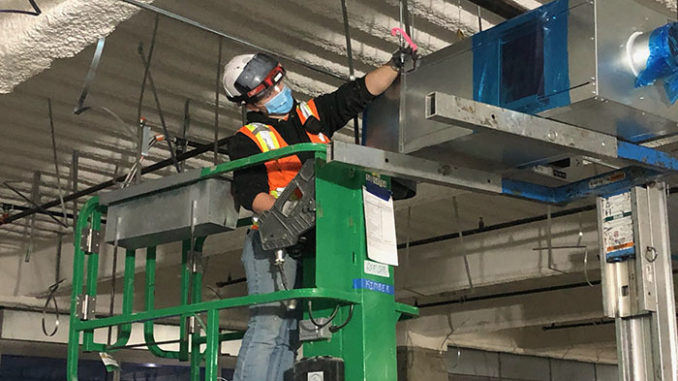
Western Washington Sheet Metal JATC’s pre-apprenticeship program provides high school students with basic skills training, insight into the sheet metal trade, and hands-on, practical experience in “a day in the life” of a sheet metal worker.
By / Jessica Kirby Photos courtesy of Kimber Jackson & Sam Wade
Jeff Reinhardt, Executive Administrator for the Western Washington Sheet Metal JATC, says the need for a pre-apprenticeship program at the training center was identified though the JATC’s recruitment outreach efforts in high schools.
“Career and Technical Education (CTE) and shop teachers were discussing ongoing efforts to prepare high school kids for jobs, and together we realized there is a need to go straight to work instead of going to college first,” he said. “After the success of our SMART Heroes program for veterans, we thought we could mimic that model for high school students. We used part of the SMART Heroes curriculum to create a six-week pre-apprenticeship program.”
To be eligible, any high school or vocational training program can nominate up to two students per year. They can be juniors or seniors, but they have to be nominated by a CTE instructor or guidance counsellor.
“Typically, I do some coaching with the CTE instructors to tell them it doesn’t have to be the person with the top score,” Reinhardt says. “It should to be the person most likely to succeed in an apprenticeship.”
That kind of suitability relies on certain characteristics, like commitment, work ethic, and long-term goals.
“We want the instructors to talk to students and find out their future wants, needs, desires, and passions for life,” Reinhardt says. “So far, we have had really good luck.
“In fact, going into this year, one school who has made recommendations in the program’s first and second years abstained for the first time. I asked why and they said they just didn’t feel they had any students they could put their name or brand on. So, it is clear the schools are really taking ownership of the process and making sure they recommend the right candidates.”
The pre-apprenticeship programs run once a year in the summer time at their DuPont and Everett training centers. Classes run Monday through Thursday, 6 a.m. to 2:30 p.m., for six weeks. There is no cost to participate, and participants are not paid. Each class can take up to 15 students per session, and at the end of it, the top five from each training center receive direct entry to the apprenticeship program, bypassing the application process.
“It turns into a bit of a competition for them,” Reinhardt says. “The other ten can still go through the application process, and having taken the pre-apprenticeship program gives them an advantage when we are considering their applications.”
Students learn safety training, including OSHA certification, basic terminology, and tool use, and if they are over 18 they complete lift training.
“A lot of it is the instructors coaching participants on what a day in the life out of high school and on the job site is like,” Reinhardt says. “Obviously, there are the hard skills, as well, and at the end they are definitely more prepared for a first-year apprenticeship than a typical applicant.”

The class of 2020 was much like the years previous, since construction was declared essential work throughout COVID, which meant the JATC was training essential workers.
“We were back open for school in May last year,” Reinhardt says. “We do the pre-apprenticeship program once the main classes are done, so we had fewer people in the building anyway and maintained social distancing and typical protocols.”
While the Western Washington Sheet Metal JATC’s apprenticeship program doesn’t currently have a shortage of applicants, the pre-apprenticeship program has begun to solve a larger industry issue—getting the word out to high school students that the trades are an attractive alternative to four-year college programs.
“Through this program, we are showing high school students that there are opportunities in the apprenticeship world,” Reinhardt says. “They don’t have to go to four years of college and accumulate four years of debt. Our students go back to their friends and families and show them they are walking out of high school, starting a job and an apprenticeship, and potentially making $50,000 a year. Who doesn’t want to be a part of that?”
After three years operating, the program continues to garner positive feedback from industry, the instructors, and graduates.
“We have ongoing word of mouth support from contractors on the JATC committee,” Reinhardt says. “The apprentices who have gone through the program have been able to stay employed, and employers love them and think they are solid apprentices. It is encouraging for us and makes us feel it is a viable program.”
When he first approached the instructors with the idea to do a pre-apprenticeship program, they were unsure. “They wondered what I was trying to do, bringing a bunch of high school kids in here,” Reinhardt says. “But after we finished with the first cohort, the instructors said it was such a cool program that they wanted to make sure we would do it again.”
Kimber Jackson participated in that first cohort. She was selected because she demonstrated she was reliable, both for quality and consistency in any projects or assignments the class required.
“My teachers believed that that work ethic would carry over to an actual workplace environment,” Jackson says. “The qualities I think would be the most beneficial in this program would be reliability and a willingness to learn.”
Jackson says she enjoyed the program, even though the first week was a bit rough waking up so early on her summer break. “Once we started working in the shop and we were learning hands on, it became a lot more fun,” she says.
The program was instrumental in preparing her for the apprenticeship program because it provided a general understanding of the trade and its requirements, and most importantly, it provided first-hand experience of what a normal workday could entail. “And,” she says, “it also helped me get a foot in the door to actually getting into the apprenticeship program.”
Jackson is currently employed full-time in Bellevue. Her main goal at the moment is to complete her five-year apprenticeship program and learn everything she can.
“After that, I am sure I will have a better understanding of the many aspects of the trade, and I will be able to choose my route from there,” she says.
She says anyone looking for insight into a career in sheet metal and who wants a practical, hands-on sample of a day in the life should strive to complete a pre-apprenticeship program.
“I do strongly recommend joining a pre-apprenticeship if a person is interested in the trades,” she says. “It isn’t for everyone. The wake-ups are rough and some days are pretty slow, but overall it is an incredible opportunity and a great chance to learn a useful, practical skillset—and the trade pays really well!”
For Sam Wade, graduate from the 2019 pre-apprenticeship course, it was his immense interest in the trades and his ability to do well in both the school atmosphere as well as the shop that got his shop teacher’s attention. “Some qualities that I feel made me a good choice are being dependable, dedicated, motivated, ambitious, and, most importantly, having the willingness to learn,” Wade says.
The decision to attend was one he will never regret. “It was an amazing program, and I found myself looking forward to being there whenever I wasn’t,” Wade says, noting the six weeks were a “crash course” in everything from hand layout and OSHA 10 to drafting, shop fab, and welding.
“This absolutely helped prepare me for the apprenticeship,” Wade says. “Coming in as a completely green first-year apprentice, they don’t expect much. It was extremely helpful to be able to show that I had some of the basic knowledge of the trade. I feel it helped me not only gain more respect but opened them up to letting me try some of the more advanced projects.”
Wade feels fortunate to have stayed employed throughout the tough COVID-19 months, and he is currently working on the Fife Elementary job for Northwest Mountain Air.
“My goals in the future are high,” he says. “I’m trying to stay focused on completing the apprenticeship without being late on anymore work reports, which is currently my biggest struggle. However, my true goals are to journey out and eventually become a foreman. Perhaps one day I’ll become an owner of my very own shop.”
Like Jackson, Wade highly recommends the pre-apprenticeship program and the sheet metal trade in general to other young people. “Don’t hesitate,” he offers. “The idea of committing yourself to a trade program for years can sound very intimidating, but I can speak firsthand that it can be unbelievably beneficial.
“So, my advice would be that if you’re hesitant in joining an apprenticeship program, jump in with both feet. You can only get something out of it if you first put something into it.” ▪



